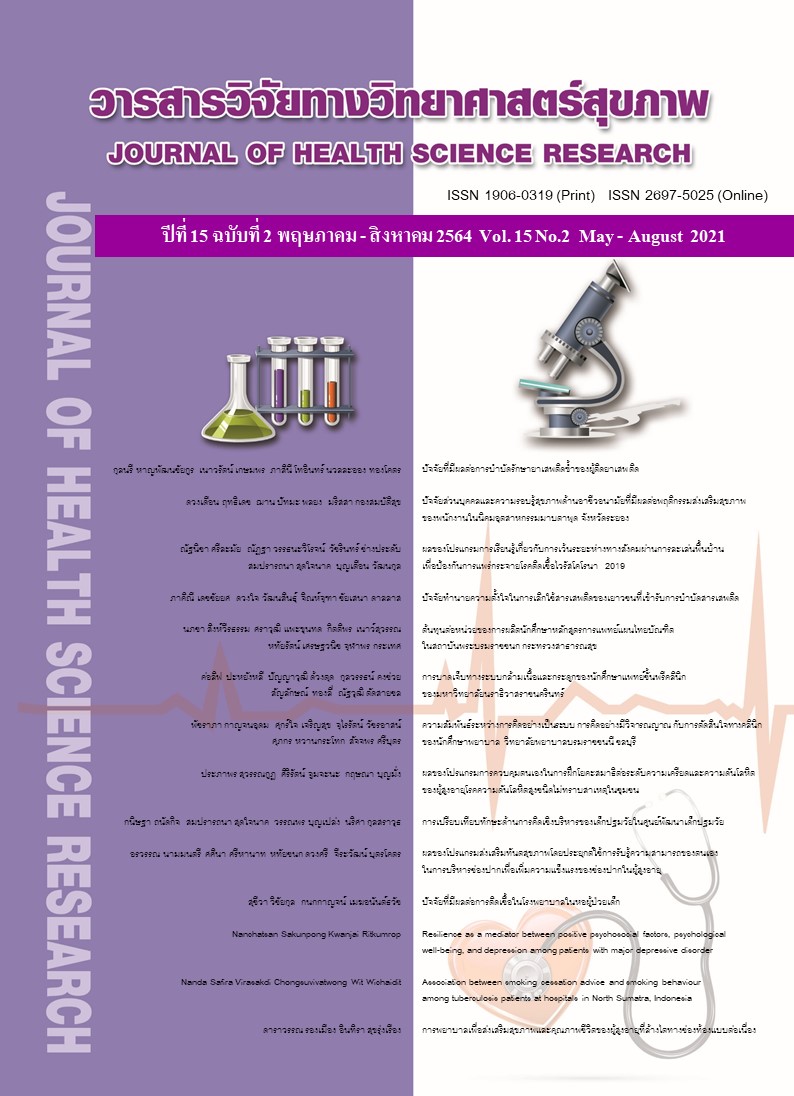The ผลของโปรแกรมการควบคุมตนเองในการฝึกโยคะสมาธิต่อระดับความเครียดและความดันโลหิตของผู้สูงอายุโรคความดันโลหิตสูง ชนิดไม่ทราบสาเหตุในชุมชน
Main Article Content
บทคัดย่อ
บทนำ : โรคความดันโลหิตสูงเป็นปัญหาที่สำคัญของประเทศไทยและทั่วโลก ซึ่งส่งผลต่อการดำเนินชีวิตของผู้ป่วยและครอบครัว นอกจากนี้ยังเป็นปัจจัยเสี่ยงให้เกิดปัญหาแทรกซ้อนต่าง ๆ ตามมา
วัตถุประสงค์การวิจัย : เพื่อศึกษาผลของโปรแกรมการควบคุมตนเองโดยการฝึกโยคะสมาธิต่อระดับความเครียดและความดันโลหิตของผู้สูงอายุในชุมชนที่ป่วยด้วยโรคความดันโลหิตสูง
วิธีการวิจัย : วิจัยกึ่งทดลองแบบกลุ่มเดียววัดผลก่อนหลัง ตัวอย่าง จำนวน 30 คน ได้เข้าร่วมโปรแกรมเป็นระยะเวลา 8 สัปดาห์ เครื่องมือที่ใช้รวบรวมข้อมูล ประกอบด้วย แบบสอบถามข้อมูลทั่วไป
แบบประเมินความเครียดสวนปรุง (SPST-20) และชุดเครื่องวัดความดันโลหิตมาตรฐานชนิดปรอท โดย หาความเที่ยงของแบบประเมินความเครียดด้วยวิธีสัมประสิทธิ์แอลฟาของครอนบาคเท่ากับ .86 วิเคราะห์ข้อมูลโดยใช้สถิติพรรณนา และทดสอบค่าที
ผลการวิจัย : หลังการเข้าร่วมโปรแกรม ค่าเฉลี่ยคะแนนความเครียดของตัวอย่างต่ำกว่าก่อนการทดลองอย่างมีนัยสำคัญทางสถิติที่ระดับ .05 ค่าเฉลี่ยความดันซีสโตลิคและความดันไดแอสโตลิคของ ตัวอย่างต่ำกว่าก่อนการทดลองอย่างมีนัยสำคัญทางสถิติที่ระดับ .05
สรุปผล : การทำโยคะสมาธิสามารถลดระดับความเครียด และระดับความดันโลหิตในผู้สูงอายุที่ป่วยด้วยโรคความดันโลหิตสูงชนิดไม่ทราบสาเหตุได้
Downloads
Article Details
บทความที่ได้รับการตีพิมพ์เป็นลิขสิทธิ์ของวิทยาลัยพยาบาลบรมราชชนนี จังหวัดนนทบุรี
ข้อความที่ปรากฏในบทความแต่ละเรื่องในวารสารวิชาการเล่มนี้เป็นความคิดเห็นส่วนตัวของผู้เขียนแต่ละท่านไม่เกี่ยวข้องกับวิทยาลัยพยาบาลบรมราชชนนี จังหวัดนนทบุรี และคณาจารย์ท่านอื่น ในวิทยาลัยฯ แต่อย่างใด ความรับผิดชอบองค์ประกอบทั้งหมดของบทความแต่ละเรื่องเป็นของผู้เขียนแต่ละท่าน หากมีความผิดพลาดใด ๆ ผู้เขียนแต่ละท่านจะรับผิดชอบบทความของตนเองแต่ผู้เดียว
เอกสารอ้างอิง
World Health Organization. A global brief on hypertension: silent killer, global public health crisis: World Health Day. [internet]. 2013. [cited 2018 Jan 20]. Available from: http://ishworld.com./dowload s//pdf/global_brief_hypertension.pdf.
Public Health System Development Group Bureau of Non-communicable Diseases Department of Disease Control. World Hypertension Day Campaign. [internet]. 2018. [cited 2018 Mar 1]. Available from: http://khosod.co.th/monitor-news/ news_1421769. (in Thai).
ICT Office of Permanent Secretary. Report NCDs.[internet]. 2020 [cited 2020 Dec 10] Available from: https://pte.hdc. moph.go.th/hdc/reports/report.php?source= pformated/format1.php&cat_id=b2b59e64c4e6c92d4b1ec16a599d882b&id=2e3813337b6b5377c2f68affe247d5f9. (in Thai).
Sarkar A, Roy D, Chauhan MM, Dave P, Makwana NR, Parmar DV. A lay epidemiological study on coexistent stress in hypertension: Its prevalence, risk factors, and implications in patients' lives. J Family Med Prim Care. 2019;8(3):966-71. doi: 10.4103/jfmpc.jfmpc_60_19.
Rengganis AD, Rakhimullah AB, Garna H. The correlation between work stress and hypertension among industrial workers: A cross-sectional study. IOP Conference Series: Earth and Environmental Science. 2020;441: 1-5. doi:10.1088/1755-1315/441/1/012159.
Department of Thai Traditional and Alternative Medicine. Yoga for chronic disease. [internet]. 2019. [cited 2019 Aug 5]. Available from: https://thaicam.go.th/wp-content/uploads/. (in Thai).
Suwannakich P, Sukted P, Wongsa S, Audta, Saengpanya N. Effects of sahaja yoga practice on blood pressure, heart rate and stress among hypertension patients. Journal of Nursing and Health Science. 2010;4(2):28-35. (in Thai).
Lu X, Juon H, He X, Dallal CM, Wang MQ, Lee S. The association between perceived stress and hypertension among Asian Americans: Does social support and social network make a difference? J Community Health. 2019; 44(3):451–62. doi: 10.1007/s10900-018-00612-7.
Satyanand V, Reddy B, Shaik M, Mohanan D, Salma S, Nuzhath FJ. Effect of yoga on hypertension. Narayana Medical Journal. 2016;5(1):5-11.
Nejati S, Zahiroddin A, Afrookhteh G, Rahmani S, Hoveida S. Effect of group mindfulness-based stress-reduction programm and conscious yoga on lifestyle, coping strategies, and systolic and diastolic blood pressure in patients with hypertension. J Teh Univ Heart Ctr. 2015;10(3):140-8. PMID: 26697087.
Suvarnarong K. The path of yoga: The science challenging nurses’ role, Journal of Nursing Science. 2014;32(4):15-24. (in Thai).
Burn N, Grove SK. The practice of nursing research, conduct, critique, and utilization. 4th ed. Philadephia: W.B. Saunders; 2001.
Mahatnirunkul S, Pumpaisalchai W, Tapanya P. Suanprung stress test. Chiang Mai: Suanprung hospital; 1997. (in Thai).
Leventhal H, Johnson JE. Laboratory and field experimentation: Development of a theory of self-regulation. In: Wolldridge PJ, Schmitt MH, Skipper JK, Leonard RC, editors. Behavioral science and nursing theory. Mosby: St. Louis; 1983.
Kantharadusadee-Triamchisri S. Meditation practice for health remedies. 11th ed. Bangkok; 2011. (in Thai).
Kosirimongkol V, Ua-kit N, Tantikosoom P. The effects of slow breathing exercise program on blood pressure levels among essential hypertensive patients. Journal of The Police Nurses. 2018;10(1):30-40. (in Thai).
Prasawang N, Koshakri R, Jewpattankul Y. Effects of the sitting breathing meditation combined with usual care on blood pressure among patients with essential hypertension in primary care unit. Journal of Nursing and Health Care. 2018;36(1):33-42. (in Thai).
Wolff M, Sundquist K, Lonn SL, Midlov P. Impact of yoga on blood pressure and quality of life in patients with hypertension – a controlled trial in primary care, matched for systolic blood pressure. BMC Cardiovasc Disord. 2013;13(111):1417-2261. doi: 10.1186/1471-22 61-13-111.


